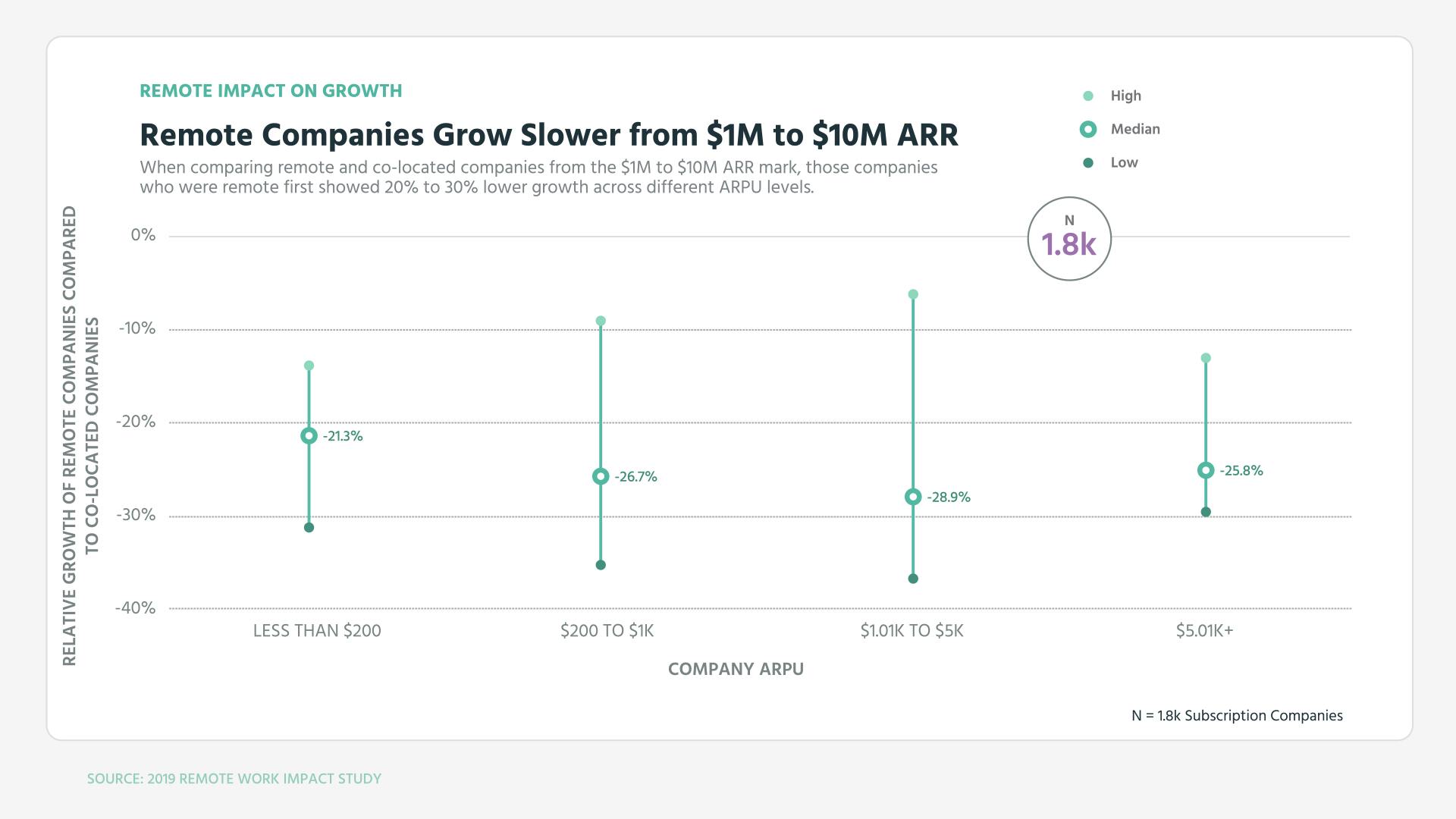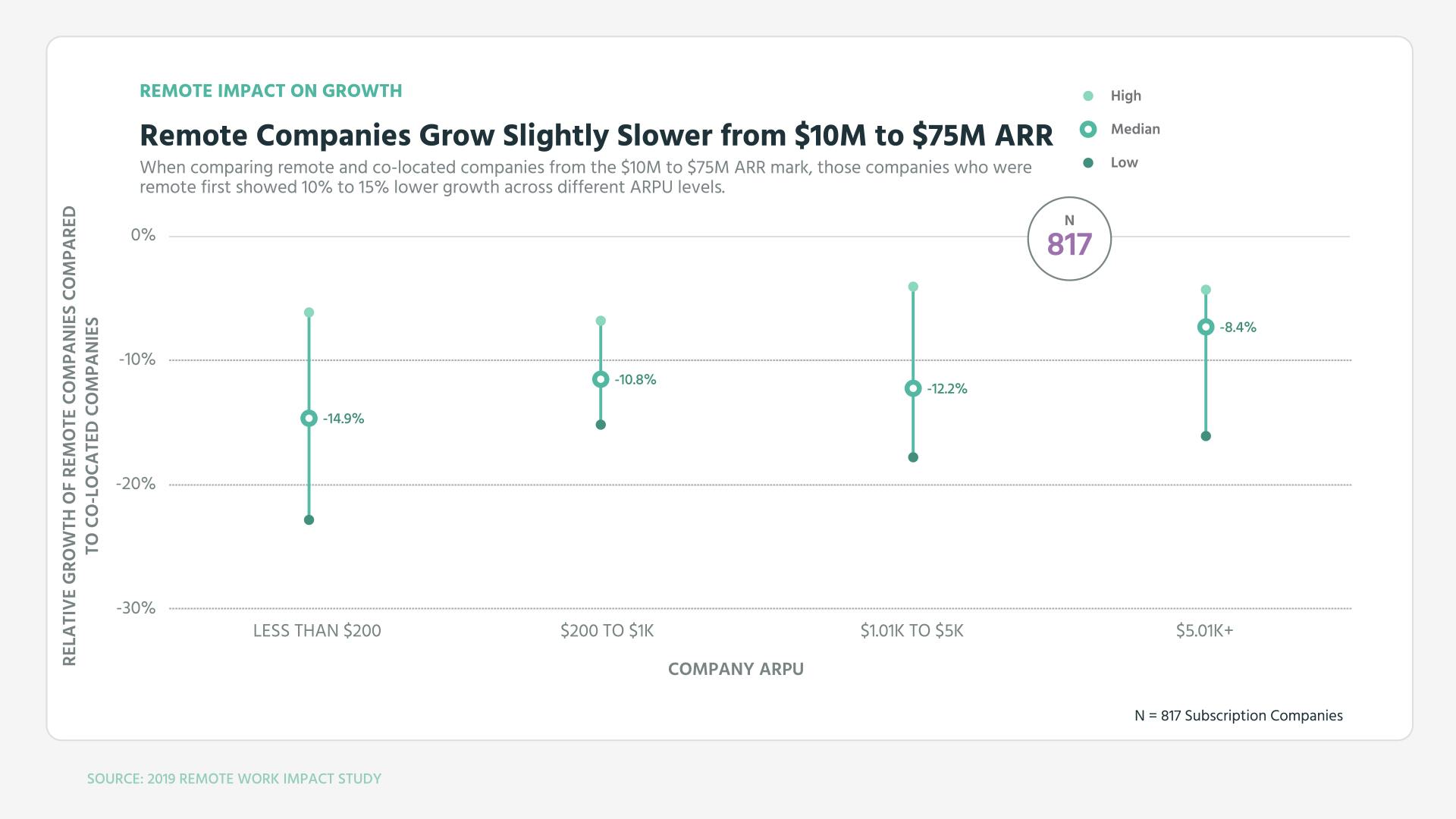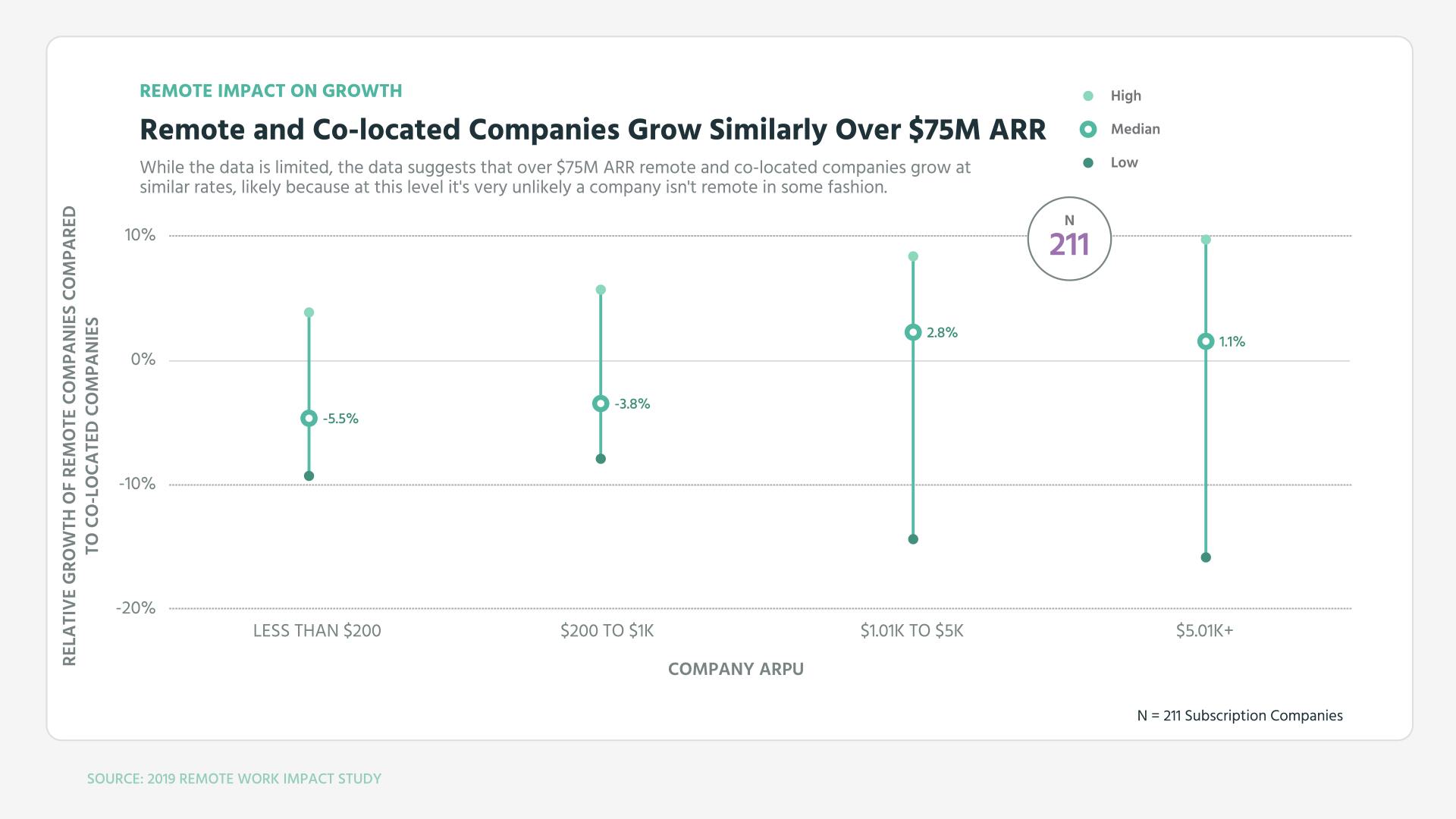
Are Remote Teams Growing Slower Than Their Co-located Counterparts?
This episode might reference ProfitWell and ProfitWell Recur, which following the acquisition by Paddle is now Paddle Studios. Some information may be out of date.
Originally published: July 19th, 2019
This is the type of study that we’re going to lose friends over, even though there’s an incredible amount of nuance.
Remote company cultures have become more akin to a religion than a growth strategy with amazing people that I respect so, so very much, like DHH from Basecamp, Nick Francis from Help Scout, and Wade Foster from Zapier preaching the power of remote / working from home.
But first, if you like this kind of content and want to learn more, subscribe to get in the know when we release new episodes.

In the early stages, remote companies are growing at a much slower rate than those companies where everyone is co-located.
You’re seeing here a blend of a lot of different types of companies that are doing anywhere from $1M to $10M in annual revenue. Note that no matter the ARPU, which is charitable proxy for different types of teams, remote teams have growth rates that are roughly 20 to 30% lower than co-located teams.

What’s fascinating though is that as companies get larger, this growth differential starts to diminish.
When we look at a similar split of companies, but now looking at those doing $10M to $75M, you’ll note that the difference has essentially halved to remote teams growing 10 to 15% percent less than co-located teams.

You’re obviously seeing some survivor bias with this data, but when you think about it, this trend stands to reason. By $10M you probably have figured out your main channels and definitely product/market fit, so remote is less of an issue.
That’s not to say that figuring out product market fit and your channels requires you to be in the same room with one another, but it’s likely easier.
When we look at companies doing more than $75M, this growth differential essentially disappears, although the data is fairly sparse.

That being said, most companies when you get to this level have evolved to a point where they’re remote anyways with multiple offices, a contingent of folks who work from home, and obviously a high volume of different types of team members.
On the other hand, we do also see companies bring people back to the mothership when times get tough - like Yahoo and Reddit - to name a couple.
So should we say screw remote teams? Not exactly. There are a few big pieces to keep in mind here. For one, as stated previously all companies go remote or multi-office at some point, so it’s not an argument of either/or, it’s more of an argument of when.
Further, a lot more research needs to be done here, because the big question is why we’re seeing this data. Is it because co-located teams handle ambiguity better? Is it because of a technological connection problem that will diminish over time making the trend reverse?
Want to learn more? Check out our recent episode on The pricing power of 9 and subscribe to the show to get new episodes.

1
00:00:00,320 --> 00:00:03,520
You've got the questions,
and we have the data.
2
00:00:03,520 --> 00:00:06,620
This is the ProfitWell Report.
3
00:00:08,335 --> 00:00:11,455
This is Shyamili, CEO
of Surfboard Digital.
4
00:00:11,455 --> 00:00:15,135
And my question to you
today is how do remote teams
5
00:00:15,135 --> 00:00:16,270
impact growth?
6
00:00:16,270 --> 00:00:17,070
Bye.
7
00:00:17,070 --> 00:00:20,350
Welcome back, everyone. Neil
here for the ProfitWell Report.
8
00:00:20,350 --> 00:00:22,990
This is the type of study that
we are going to lose friends
9
00:00:22,990 --> 00:00:26,490
over even though there is
an incredible amount of nuance.
10
00:00:26,505 --> 00:00:29,545
Remote company cultures have
become more akin to a religion
11
00:00:29,545 --> 00:00:33,280
than a growth strategy with
amazing people that we respect
12
00:00:33,280 --> 00:00:36,240
so so much, like Nick
Francis from Help Scout,
13
00:00:36,240 --> 00:00:39,760
Wade Foster from Zapier,
and DHH from Basecamp.
14
00:00:39,760 --> 00:00:42,705
Yet what does the data
tell us about remote teams?
15
00:00:42,705 --> 00:00:45,425
To explore the power or
lack thereof of remote,
16
00:00:45,425 --> 00:00:47,745
we looked at just over
three thousand subscription
17
00:00:47,745 --> 00:00:49,890
companies, and
here's what we found.
18
00:00:49,890 --> 00:00:51,090
In the early stages,
19
00:00:51,090 --> 00:00:53,810
remote companies are growing at
a much slower rate than those
20
00:00:53,810 --> 00:00:55,970
companies where
everyone is co located.
21
00:00:55,970 --> 00:00:58,245
You're seeing here a blend of
a lot of different types of
22
00:00:58,245 --> 00:01:00,325
companies that are doing
anywhere from one to ten
23
00:01:00,325 --> 00:01:02,485
million in annual revenue.
24
00:01:02,485 --> 00:01:04,005
Note that no matter the ARPU,
25
00:01:04,005 --> 00:01:07,180
which is a charitable proxy
for different types of teams,
26
00:01:07,180 --> 00:01:09,500
remote teams have growth rates
that are roughly twenty to
27
00:01:09,500 --> 00:01:12,840
thirty percent lower
than colocated teams.
28
00:01:12,940 --> 00:01:16,075
What's fascinating, though, is
that as companies get larger,
29
00:01:16,075 --> 00:01:18,635
this growth differential
starts to diminish.
30
00:01:18,635 --> 00:01:20,635
When we look at a similar
split of companies,
31
00:01:20,635 --> 00:01:23,595
but now looking at those doing
ten to seventy five million,
32
00:01:23,595 --> 00:01:25,810
you'll notice that the
difference has essentially half
33
00:01:25,810 --> 00:01:28,770
the remote teams growing ten
to fifteen percent less than
34
00:01:28,770 --> 00:01:30,530
colocated teams.
35
00:01:30,530 --> 00:01:33,650
Now you're obviously seeing some
survivor bias with this data.
36
00:01:33,650 --> 00:01:37,055
But when you think about
it, this trend stands to reason.
37
00:01:37,055 --> 00:01:39,695
By ten million, you probably have
figured out your main channel is
38
00:01:39,695 --> 00:01:43,680
indefinitely product market fit,
so remote is less of an issue.
39
00:01:43,680 --> 00:01:46,320
That's not to say that figuring
out product market fit and your
40
00:01:46,320 --> 00:01:49,120
channel requires you to be in
the same room with one another,
41
00:01:49,120 --> 00:01:50,885
but it's likely easier.
42
00:01:50,885 --> 00:01:53,845
When we look at companies
doing more than seventy five million,
43
00:01:53,845 --> 00:01:56,485
this growth differential
essentially disappears,
44
00:01:56,485 --> 00:01:58,725
although the data
is fairly sparse.
45
00:01:58,725 --> 00:01:59,940
That being said,
46
00:01:59,940 --> 00:02:02,260
most companies when you get to
this level have evolved to a
47
00:02:02,260 --> 00:02:03,940
point where they're
remote anyways.
48
00:02:03,940 --> 00:02:04,340
Right?
49
00:02:04,340 --> 00:02:07,060
With multiple offices,
contingent of folks who work
50
00:02:07,060 --> 00:02:08,695
from home, and obviously,
51
00:02:08,695 --> 00:02:10,775
a lot of different
types of team members.
52
00:02:10,775 --> 00:02:11,575
On the other hand,
53
00:02:11,575 --> 00:02:14,055
we do see companies bring
people back to the mothership
54
00:02:14,055 --> 00:02:17,750
when times get tough, like Yahoo
and Reddit to name a couple.
55
00:02:17,750 --> 00:02:21,430
So should we say screw remote
teams? Not exactly. Right?
56
00:02:21,430 --> 00:02:24,275
There are a few big pieces
to keep in mind here.
57
00:02:24,275 --> 00:02:25,875
For one, as stated previously,
58
00:02:25,875 --> 00:02:29,395
all companies go remote or multi
office at some point anyway.
59
00:02:29,395 --> 00:02:31,075
So it's not an
argument of either or.
60
00:02:31,075 --> 00:02:33,490
It's more of an
argument of when.
61
00:02:33,490 --> 00:02:36,130
Further, a lot more research needs
to be done here because the big
62
00:02:36,130 --> 00:02:38,210
question is why we're
seeing this data.
63
00:02:38,210 --> 00:02:41,215
Is it because collocated
teams handle ambiguity better?
64
00:02:41,215 --> 00:02:42,975
Is it because of the
technological connection
65
00:02:42,975 --> 00:02:46,095
problem that will diminish over
time making this trend reverse?
66
00:02:46,095 --> 00:02:48,015
There are a lot of
unanswered questions here.
67
00:02:48,015 --> 00:02:52,160
Finally, though, this also assumes
growth is what you're optimizing for,
68
00:02:52,160 --> 00:02:54,640
which I know sounds a little
preposterous to question,
69
00:02:54,640 --> 00:02:58,400
but growth can have a cost on team
membership happiness and health.
70
00:02:58,400 --> 00:03:01,025
You also may not care about
growth above everything else,
71
00:03:01,025 --> 00:03:03,745
which a lot of folks in the
remote camp have stated is not
72
00:03:03,745 --> 00:03:05,185
what they're all about.
73
00:03:05,185 --> 00:03:07,345
Ultimately, there's an
element of choice here,
74
00:03:07,345 --> 00:03:09,185
and more research is needed.
75
00:03:09,185 --> 00:03:11,090
For now, that's
all for this week.
76
00:03:11,090 --> 00:03:12,050
If you have a question,
77
00:03:12,050 --> 00:03:15,170
send me an email or video to
nia at proper well dot com.
78
00:03:15,170 --> 00:03:18,195
If you got value here or any
other week of the report,
79
00:03:18,195 --> 00:03:20,675
we appreciate any and all
shares on Twitter and LinkedIn
80
00:03:20,675 --> 00:03:22,595
because that's how we
know to keep doing this.
81
00:03:22,595 --> 00:03:24,415
I'll see you next week.
82
00:03:26,420 --> 00:03:29,220
This week's episode is
brought to you by Reforge,
83
00:03:29,220 --> 00:03:32,020
selective programs for
experienced professionals in
84
00:03:32,020 --> 00:03:35,749
marketing, product,
data, and engineering.
85
00:03:35,929 --> 00:03:37,909
Reforge dot com.





